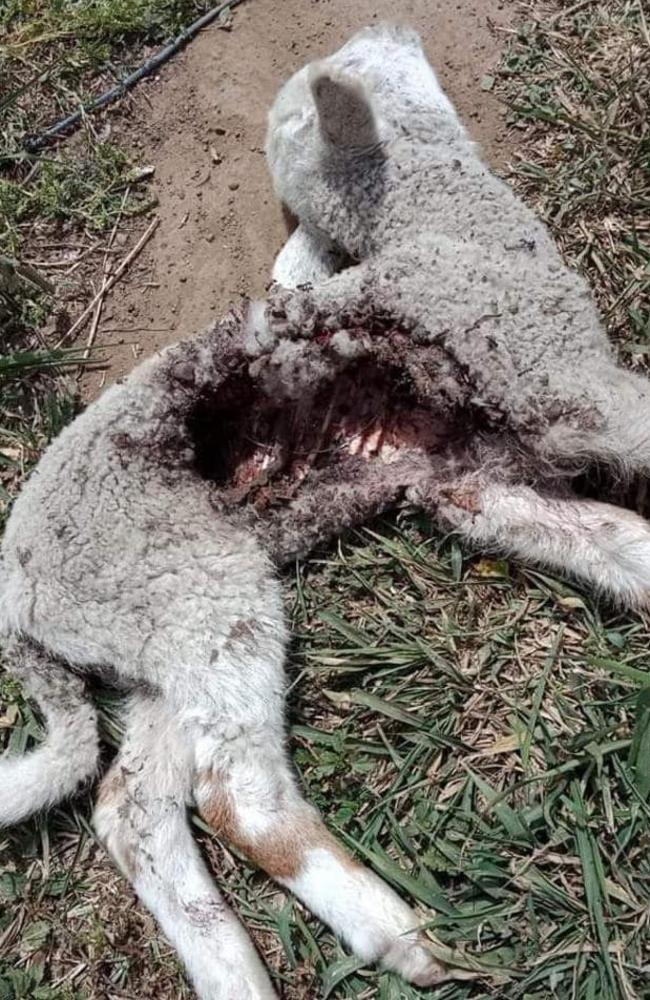Several more dogs are believed to have died from suspected 1080 poisoning.
A farmer is calling for tighter policing on the use of a controversial poison used for pest management after she suddenly lost three dogs in three hours from suspected 1080 baiting. WARNING: DISTRESSING VIDEO AND IMAGES
QLD News
Don't miss out on the headlines from QLD News. Followed categories will be added to My News.
WARNING: DISTRESSING VIDEO AND IMAGES
A Central Queensland farmer is calling for tighter policing on the use of a controversial poison used for feral pest management after she suddenly lost three dogs from suspected 1080 baiting.
The woman, who asked not to be named, said the dogs were in their own yard when they suddenly died within three hours of each other after first “going ballistic” and having seizures one morning.
She said a neighbour also came home to find his dog and her three puppies unexpectedly dead in their cage only a week earlier from unknown causes.
GRIEVING PET OWNERS WANT CONTROVERSIAL POISON BANNED
AUSSIES URGED TO CALL FOR REVIEW INTO 1080 USE
The chemical sodium fluoroacetate, commonly known by its brand name of 1080, is a highly toxic, odourless pesticide that is injected into meat, grain or carrots to make baits.
Although it has been banned in many countries, 1080 is used by the government and private landholders in Australia to kill introduced “pest species” such as feral dogs, dingoes, foxes, cats, rabbits, pigs, and in some cases, native wildlife.
Many proponents of the bait state 1080 is essential for farmers to protect their livestock from being mauled by feral dogs, and that it was safe for most native animals, while many opponents want it banned, saying it was an inhumane way to kill animals.
Both opponents and proponents of the poison have claimed some baiting programs had been “mismanaged” resulting in both confirmed and suspected deaths of “non-target” animals.
Some of the most recent accidental “non-target” deaths have included 13 pets who mostly died in their own yards, in separate areas of Queensland, after either ingesting a bait or from secondary 1080 poisoning after coming in contact with a poisoned dog’s vomit or saliva.
The Mt Larcom woman said although she did not want the pesticide banned, she did believe the laws surrounding its use were too lax.
THE FATEFUL MORNING
The cattle farmer said her 7-year-old Labrador, Sooki, started acting strange after being let out of the house about 5.30am October 24.
“She was looking at something in the yard. I actually thought she had seen a snake, the way she was looking, but I went out to look and there was nothing there,” she said.
About 30 minutes later, Sooki started madly sprinting around the house before abruptly having a seizure.
“It was unusual for her to run, full stop. She’s a retired breeding Labrador and pushing eight,” Sooki’s owner said.
“She doesn’t do much of anything she doesn’t have to, but she was acting very hyperactive.”
The woman immediately rang her vet.
“The vet asked if she had gotten any poison. I said ‘no she has been inside with me, we don’t have any rat baits out’,” she said.

Sooki was rushed into the car for the 30km drive to the closest veterinary surgery, but died halfway through the trip.
In tears, the woman – who was now covered in vomit and saliva from Sooki – drove straight home and checked on the other six dogs, including 1-year-old’s Stumpy, a Maltese Shih tzu, Patch, a kelpie cross and four other Labradors of various ages.
Only Sooki and Stumpy slept in the house, while the other dogs were still locked in their overnight pens.
The 33-year-old soon heard a “God awful bark and howl” coming from her daughter’s bedroom.
“The Maltese shihtzu was backed in a corner and, I don’t know how to describe it, just fretting and howling and yowling and yodelling,” she said.
“I picked him up and held him and he was seizing in my arms. He did that for about seven minutes before he passed away.”
FIVE DOGS DEAD IN FIVE HOURS FROM SUSPECTED 1080 BAITING
FOUR PETS ON SAME ROAD DEAD WITHIN DAYS OF EACH OTHER
She placed Stumpy on a blanket on the verandah until her husband, who was burying Sooki, could also bury the little three-legged pup.
The couple, who were now concerned about their young children possibly getting hurt, let Patch out to check for snakes.
They followed the kelpie cross everywhere while he searched inside and outside the house, not letting him out of their sight, though he did also sniff Stumpy’s now empty blanket.
When no snakes were found, Patch was returned to his pen.
Shortly after, the woman was on the phone to a friend discussing 1080 when the working dog started to thrash around and back into the corner of his kennel in distress.
“As I was talking to my girlfriend, it hit Patch as well. I immediately said ‘It’s not a snake,” she said.
“He was making ballistic noises, and he was looking around like he was hallucinating.
“I let my young dog (who was in the pen with him) out and reached into to try to comfort Patch and he tried to bite me. He had never done that before,” she said.
“I couldn’t do anything for him. I had to shut the kennel and hope to God he didn’t infect the other dogs. I couldn’t even put him out of his misery … as we don’t have any guns.”

FARMER: TIGHTER RESTRICTIONS NEEDED
The shocked woman said tighter restrictions should be enforced for those who baited with 1080 as there had been no public notifications or bait warning signs erected in her area, as are required under state law.
“We’re farmers as well, it’s not my intention to blame anyone,” she said.
“I don’t believe the laws are stringent enough, when we live in the close proximity that we do, and I don’t believe they are being policed.
“I have my personal grievances with the poison, but I understand it’s perhaps a necessary evil to control feral pests, if there’s a need.”
“If this were my 4-year-old that had picked baits up in our yard, we would be having a very different conversation,” she said.
The dog owner reported the deaths to the Gladstone Regional Council, but they said the most recent approval given to someone to lay baits was in September and that property was 4km from her 125 acre home.
WILD DOGS OUT OF CONTROL IN QUEENSLAND
HEARTWRENCHING MOMENT PUPPY REFUSES TO LEAVE GRAVE
Councils can vary their local distance requirements, with most only requiring bait-users to notify neighbours between 1km-2km away.
“I do believe the person who laid the bait did what he was legally supposed to do,” the Mt Larcom woman said.
“But this is where my issue starts. We have wedge tail eagles nesting close to our house. They’re big, I’ve seen them carry small kangaroos.
“I was told by a representative from the council that it was unlikely a bird would carry a bait 4km … but you can debate that till the cows come home.”
COUNCIL RESPONSE
A request by the Courier Mail to interview Gladstone Region Mayor Matt Burnett was declined, with a written statement instead issued through a media spokesman.
In the statement, Mr Burnett said the council carried out baiting programs in March or April and September or October each year, depending on the weather and the target-animal breeding cycle.
He said there were 33 participants in the region during the September baiting campaign.
The mayor said the council could not investigate the deaths of the three dogs without autopsy results.
“Reports have been made, however the Council baiting program was finished prior to these events and located several kilometres away (so) 1080 was deemed not to be the cause,” he said.
According to a 2008 review by the Australian Pesticides and Veterinary Medicines Authority (APVMA), if 1080 meat baits were not taken – or unused ones were not retrieved and disposed of at the end of an authorised baiting campaign time period – they were likely to remain lethally toxic to dogs and foxes for up to eight weeks, depending on rainfall and temperature, and may retain toxicity for up to a year under arid conditions.
The review also noted that birds and foxes had been known to move baits to other areas.

The owner of Sooki, Stumpy and Patch said had she known an autopsy would be needed, she would not have had the dogs buried immediately.
She also said there were many loopholes in the 1080 baiting program laws and questioned who policed the bait users.
“If where the baits had been laid and had not been made public, then how are we supposed to protect ourselves and our pets?” she said.
“There is no-one out there to make sure they put the baits where they’re supposed to, no-one out there to make sure they’re notifying the neighbours.
“They have to sign a form to say they’ve notified their neighbours, but nobody actually checks.
“My issue is not with the 1080, it’s with policing the laws with 1080.
“That brings in the other issue I have – are we too small? Even though we are zoned rural, are we too close in proximity to larger properties that might be baiting?”
Mr Burnett, the Gladstone mayor, said noncompliance with the Queensland legislature should be reported to Queensland Health.
The woman said she contacted Queensland Health, but was referred to the Department of Agriculture and Fisheries (DAF).
“Queensland Health told me it wasn’t an issue they handled and that DAF did. By then, I was exhausted,” she said.
A spokesman from Biosecurity Queensland, part of DAF, previously told the Courier Mail strict rules on the use of 1080 for feral animal control were set by Queensland Health.
“Confirmed cases of accidental poisonings of domestic animals are rare and there are no reported human health impacts at the dose rates imposed by State and Federal agencies,” he said.
Queensland Health has been contacted for comment but have not yet responded.
The 2008 APMVA review also highlighted the toxin’s role in protecting the Australian environment.
“Supporters of 1080 emphasised its vital importance in protecting the Australian environment and its agricultural industries from introduced vertebrate pests, noting the high effectiveness of 1080 and minimal harmful impact on non-target native animals,” it stated.
Biosecurity Queensland documents also claim 1080 was safe for most native animals as they had developed a higher tolerance to the poison, compared to introduced species, due to their evolution with naturally occurring fluoroacetate in some native plants.
